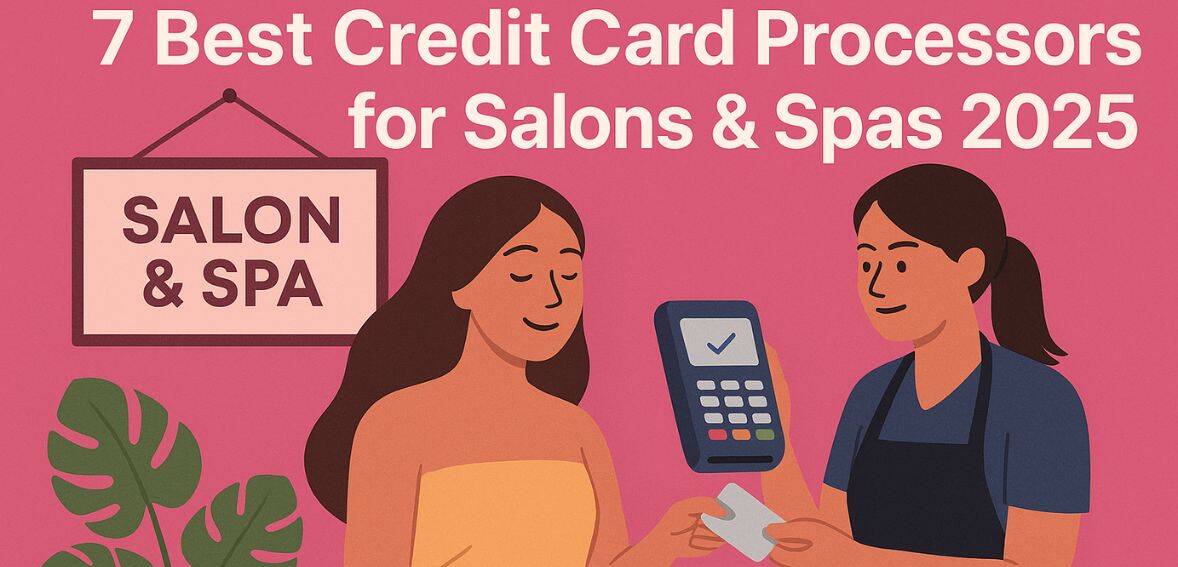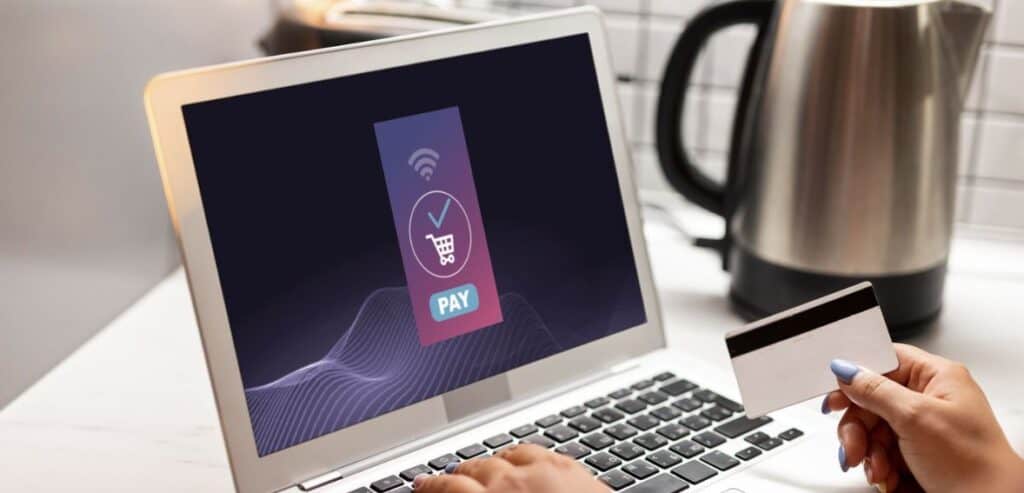
By Aiden King October 1, 2025
Managing schedules, services, inventory, and, of course, payments are all part of running a salon or spa. Transaction fees are not the only consideration when selecting the credit card processors. It affects how easily customers check out, how well you track goods and services, and how easily your business grows.
Today’s customers demand flexible, contactless, and easy payment methods. In this article, identifying a processor that facilitates the workflows of the beauty industry can transform a checkout into more than just a transaction—it can become a brand moment.
1.Square for Salons: Simple, Stylish, and Salon-Ready
Its low-stick monthly fees and free basic POS make it perfect for solo stylists or boutique spas. What makes Square stand out is its clarity—flat-rate pricing means you know your cost in advance, even when entering card details manually, and fast deposit options reduce uncertainty.
Square also integrates appointment reminders, inventory, and loyalty tools, making it a good fit for professionals who want a polished but user-friendly system. Its modest drawbacks include higher per-transaction rates compared to negotiation-based services and limited salon-specific reporting, but for lower-volume establishments, the simplicity is often worth it.
2. GlossGenius: Designed by Stylists, for Stylists
Designed with beauty professionals in mind, GlossGenius was founded by stylists who desired better tools. Its intuitive, friendly, and personal user interface makes it ideal for client-facing checkout. The platform includes digital intake forms, automated reminders, appointment scheduling, and credit card processing built right in.
While processing speeds are comparable to Square’s, GlossGenius offers more advanced stylistic features like stored cards, tipping layouts, and basic sales reporting by service provider.
3. Vagaro Pay: Where POS and Payments Unite
With integrated payment processing, support for multiple staff, automated marketing, and comprehensive reporting, Vagaro provides a comprehensive salon and spa management platform. Sales by stylist, appointment type, and product can be easily tracked thanks to its direct integration with its POS system.
With processing through its PayPro service, prices start at about $30 per month. Managers value the one-stop shop since inventory, scheduling, and merchant data are all in one place.
4. Fresha: Free Platform, Commission on Bookings
The main platform of Fresha is free, which makes it unique. Its unique revenue model involves processing credit card payments with lower-than-average fees and collecting a commission on first-time reservations.
Established spas benefit from robust booking tools and no monthly overhead, while small salons are given visibility through Fresha’s marketplace. Fresha seems like a risk worth taking if you have a dual interest in online discovery and stationary services.
5. Stripe Terminal + Salon Tech Apps: Builders’ Dream
Stripe Terminal is a versatile API that allows developers to incorporate payments into unique apps; it is not a complete platform. For salons that currently use or intend to create custom booking apps, this is perfect.
For complete functionality, Stripe integrates with salon-specific software and accepts in-person tap, chip, or swipe payments. A unified tech stack, robust brand control, and access to Stripe’s suite of financial and fraud tools are the outcomes, even though that it necessitates technical know-how.
6. Pabau Pay: Medical Meets Beauty
Pabau Pay is ideal for salons and medspas that blend beauty with medical-grade services like injectables, skin therapy, or health consultations. Originating in the clinical world, Pabau brings HIPAA-level client recordkeeping to the salon space.
Its payment system supports pre-appointment deposits, recurring packages, refunds, and installment payments. Monthly pricing is higher than more generalist platforms, but the benefits include unified client history, consent forms, treatment tracking, and billing.
Pabau Pay stands out by reducing administrative work for high-complexity service providers, giving them the structure needed for compliance and professionalism in both beauty and wellness settings.
7. Boulevard: Robust & Feature-Rich
Boulevard is a feature-rich system made for high-end spas or larger salons with multiple locations. Digital contracts, client self-scheduling, membership auto-renewals, deposits, and stylist commission tracking are all supported.
The platform is renowned for providing exceptional customer service, and its payment processing is smooth. Although some users ask for improved mobile app functionality, the platform’s strength and adaptability make it a solid option for expanding companies.
Fee Structures to Mind: Transparency Is Key

The details are crucial when examining each processor. Some employ flat-rate pricing, which is simpler to predict but frequently costs more per transaction. Others employ interchange-plus models, which are more difficult to compute but may be more economical at scale.
Keep an eye out for extra fees as well. The ideal processor should align with your volume and growth strategy. Lower-volume salons may benefit from simplicity, while larger businesses can negotiate better rates through interchange-plus models. Always review terms carefully.
A Holistic Recommendation Framework
Four main factors determine which processor is best:
- Business Size and Volume: Are you a solo stylist, boutique spa, or a multi-location chain?
- Requirements for features: Do you need memberships, deposits, commission tracking, or integrated reminders?
- Cash Flow Priorities: Is faster funding or predictable billing more important?
- Customer Experience: Do you want stored card data, touchless tipping, or mobile checkouts?
Choosing based on a combination of these needs ensures that your payment processor adds value at every touchpoint.
Navigating the Real Cost of Credit Card Processing in 2025

It takes more than just comparing transaction costs and monthly subscriptions to determine which credit card processors are best for salons and spas in 2025. The true cost is a complicated mix of client satisfaction, payout consistency, dispute resolution, setup simplicity, and flexibility to accommodate the salon’s expansion.
Many salon owners start out by selecting a well-known processor, but after months of dealing with unanticipated expenses, sluggish deposits, or a dearth of features tailored to their industry, they decide to switch. The emotional work associated with payment systems is frequently disregarded.
Choosing the right salon payment processing ensures that every transaction reflects both professionalism and care, supporting smooth operations and satisfied clients. In addition to being inconvenient, a broken point-of-sale system during busy times can result in lost sales, unhappy customers, and even a decline in trust. Spa workers and stylists dedicate their days to creating individualized treatments.
Therefore, the technology must reflect the same dependability and sophistication as their services when customers arrive at the checkout counter. Many owners of beauty businesses now give preference to payment processors who recognize the distinctiveness of their service environment because of this balance between front-of-house elegance and back-end efficiency.
Adapting to Digital-First Clients

The digitization of consumer expectations is one of the major changes influencing payment decisions in 2025. Customers of today expect seamless checkouts, not just prefer them. The typical beauty service experience now includes contactless payments, tap-to-pay, in-app tipping, and stored card data.
For many, convenience, security, and trust are more important than time savings. Offering Google Pay or Apple Pay to customers reflects their lifestyle. It implies that the company respects their time and is aware of contemporary customs. This implies that managing gift cards, packages, recurring payments, and multi-visit services is now a necessary infrastructure feature rather than a nice-to-have.
Salons that provide tiered beauty plans or memberships require processors that can manage auto-renewals with little administrative effort. In a socially conscious industry like beauty, it is also important to be able to split payments among friends or initiate refunds instantly. Processors who facilitate this flexibility see an increase in customer loyalty and a decrease in administrative burdens.
Behind the Numbers: Interchange, Margins, and Control
Processing fees are frequently misunderstood. Unaware that a larger salon could bargain for lower rates using an interchange-plus model, a salon may select a provider offering 2.6% + 10¢ per swipe. For instance, a salon that accepts card payments for $50,000 a month may discover that a 0.3% discrepancy results in hundreds of dollars in savings.
That could be put back into client amenities, stylist bonuses, or better equipment. However, for a solo stylist who prefers consistency and does not wish to examine monthly statements, a flat-rate service might be more appropriate. Furthermore, by eliminating the need for third-party software, payment processors with integrated tools frequently have marginally higher fees.
Dispute Handling and Chargebacks in the Salon Industry
Owners of salons and spas may find chargebacks particularly annoying. The majority of beauty service transactions take place in person, with real-time services provided, in contrast to online retailers. However, a no-show customer still has the option to contest a cancellation fee or a charge for a service they felt was inadequate.
Even if the service was performed correctly, salons may lose hundreds of dollars in chargeback fees if they don’t have adequate documentation. Business owners can respond to client banks using templates and workflows provided by certain processors’ automated dispute resolution tools.
Others alert owners in advance to possible warning signs, such as duplicate transactions or unusually high tipping patterns. Stronger chargeback protection is provided by platforms that enable customers to digitally sign service agreements or appointment confirmations.
The Power of Embedded Booking and Payments

A truly modern processor for beauty services integrates booking and payment systems. A single client interaction chain includes making a service reservation, choosing an add-on, making a deposit, and receiving a text reminder with a link to reschedule. Many salons are now using integrated POS systems to unite booking, payments, and inventory management into a single seamless experience.
Customers won’t have to repeat procedures or enter their card information again if the payment processor and booking system work together seamlessly. As a result, there are fewer no-shows, more deposits are obtained, and client retention is improved overall.
Additionally, it lessens checkout friction. A stylist can quickly charge a client, view their stored payment information, and mark off services completed. Customers feel more in control and less uncomfortable if tipping is expected, particularly when utilizing mobile checkouts or kiosks. This matters more in spas where privacy is part of the experience. Platforms that sync deposits, balances, and completed bookings offer peace of mind and cleaner accounting.
Staffing, Access Control, and Commission Tracking

Salons with multiple stylists have different requirements than those with just one chair. These larger setups require payment processors that provide secure access to transaction history, commission tracking, and comprehensive staff management. While stylists see their tips but not the overall salon revenue, owners want to grant permissions for front desk employees to close sales without having access to payout information.
Certain processors, such as Vagaro and Boulevard, provide direct-to-stylist payouts, tier-by-tier commission tracking, and adjustable access levels. These tools reduce payroll confusion, especially when stylists rent chairs or work part-time. Salons can also better encourage retail product recommendations by combining tips, services, and retail sales into a single transaction.
This allows stylists to get paid when a client purchases a serum or shampoo after a service. In this way, processors help link employee performance with compensation and client satisfaction, building a stronger culture and clearer expectations.
Portability and Salon Mobility
Salons are not always stationary. Portability is essential for mobile spa services, pop-up events, and wedding venues. Offline functionality, mobile terminals, and handheld card readers become crucial in this situation.
By 2025, customers anticipate that even mobile stylists will provide digital invoices with tips or tap-to-pay. Inventory, appointments, and revenue tracking are all kept consistent with a mobile point-of-sale system that is in real-time sync with the salon’s main software. This mobility extends beyond outdoor activities. It has to do with freedom.
The entire experience feels more opulent when a spa technician or stylist can complete a transaction without bringing the client to the front desk, or when a stylist can accept payments while in the chair. This is especially valuable in high-end spas where clients might be wearing robes, not ready to stand in a checkout line. A well-chosen processor enhances service flow, not just financial tracking.
Conclusion: Match Your Mission with the Right Processor
The ideal credit card processor for your spa or salon supports your company’s goals rather than just your profit margin. In 2025, there are plenty of platforms that provide advanced, salon-friendly tools, regardless of your priorities: stylist independence, client convenience, quick deposits, or thorough reporting.
But when your payments are in line with your values—easiness, elegance, and efficiency—magic happens. In addition to processing a payment, you’ve created a memorable experience when your customers’ checkout feels as professional as the service they received.
Spend some time testing a few platforms, requesting demos, and getting feedback from actual users if you’re new to the market or thinking about switching. Every transaction is a touchpoint, after all. With the right credit card processor, it can also be a statement about your brand.